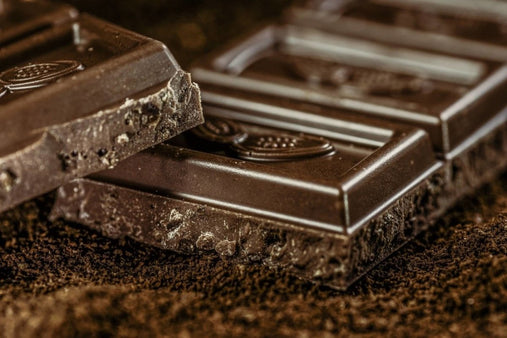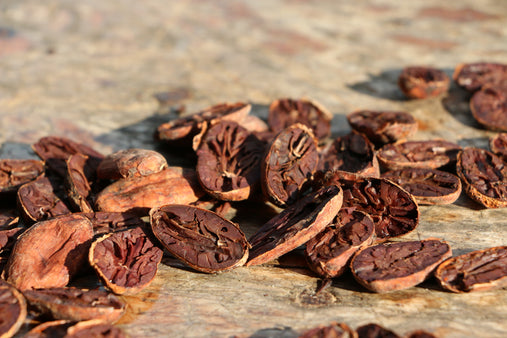
8th of May 2020
Ever wonder why eating chocolate is so fun? Here's your answer.
Cacao—the source of chocolate—is a veritable pharmacopeia of psychoactive compounds that are legal and, in most cases, quite healthy. Here’s a look at what they are and what they do, organized by category.
Endocannabinoids
Endogenous cannabinoids, also called endocannabinoids, are molecules produced by your body. One of the first endocannabinoids discovered by science is a molecule called anandamide, which is synthesized in areas of the brain that are important for memory, motivation, higher thought processes, movement control, and pleasure.
Anandamide is responsible for the blissful state we experience from activities like yoga, meditation, and general recreation; it is the chemical basis for what we call “runner’s high.” Derived from the Sanskrit word ananda (“inner bliss”), it is often referred to as the “bliss molecule.”
Interestingly, anandamide has also been discovered in two food sources: cacao and black truffles. When consumed in the form of chocolate, anandamide interacts with the same endocannabinoid receptors that THC does.
There’s also two other substances in chocolate that boost the effects of anandamide. Typically, anandamide produced in the body is rapidly broken down by the enzyme hydrolase. Chocolate contains two compounds (N-oleoyl ethanolamine and N-linoleoyl ethanolamine) that inhibit hydrolase activity and prolong the effects of anandamide.
In short…there’s a biochemical reason why dark chocolate makes you feel good.

Terpenes
Terpenes are aromatic compounds produced by plants. In many cases, they have psychoactive properties. Terpenes have recently been made fashionable by the cannabis industry, but they’ve always been a part of our lives. For example, a terpene by the name of pinene is what gives pine forests that lovely smell. When consumed by people in the proper amount, pinene also helps elevate mood, reduce inflammation, and open up respiratory pathways.
Three of the most prominent terpenes in cannabis are myrcene, linalool, and ocimene. Each of these terpenes also naturally occur in cacao, and one of them (linalool) plays a prominent role in shaping the flavor profile of chocolate.
As our understanding of these compounds continues to evolve, terpenes are beginning to take center stage in the cannabis industry, and could play a similar role in the chocolate industry. More research is still needed to confirm the psychoactive benefits of terpenes and determine the minimum thresholds required to produce these effects on the people who consume them.

Myrcene
In cannabis, myrcene is often the dominant terpene in indica strains. It is believed to have calming properties and to serve as a muscle relaxant. Its flavor and aroma profile is described as “earthy or musky with a slight hint of fruit.” Myrcene is also present in lemongrass, thyme, and hops.
Linalool
Linalool is another one of the most abundant terpenes in cannabis. It’s role in cacao is particularly important: it is one of the key drivers of the floral aroma found in certain “fine flavour” varieties of cacao, most notably Ecuador’s famed “Nacional”cacao variety. Recent research has found that linalool works as a natural antidepressant. It is also believed to have relaxing and anti-anxiety properties.
Ocimene
Ocimene is known for its antifungal, antiviral and anti-inflammatory effects, and it’s believed to work best when combined with other terpenes like myrcene. Leafly describes its flavor and aroma profile as “sweet and herbaceous.” Ocimene is also found in mint, parsley and basil.

Xanthines
Xanthines are a class of alkaloids that represent the world’s most widely-used stimulants: caffeine, theobromine, and theophylline. Cacao has all three of these alkaloids, and all of them make their way through the entire chocolate-making process and into your body when you consume it.
At a microbiological level, these compounds act by inhibiting the thing (adenosine) that inhibits the central nervous system. But they each generate a different range of effects.
Xanthine content in cacao, by dry weight:
• Theobromine: 0.9 - 1.34%
• Caffeine: 0.08 – 0.4%
• Theophylline: 0.02%
Theobromine is the most abundant xanthine in chocolate, but caffeine levels are also significant and play an outsized role. Theophylline levels are quite minor. So for the sake of this particular article, we’re going to focus on theobromine and caffeine.
The data in the graph above was compiled from a UK study that tested the theobromine and caffeine content of over 200 cacao samples, collected from a total of 26 countries across the world. As you can see, theobromine and caffeine levels vary widely depending on where the cacao was grown. Cacao from Ecuador, Venezuela, and Peru generally has more than twice as much caffeine as cacao from West African countries like Ghana and Ivory Coast (which produce the vast majority of the global cacao supply).
I write about this is much greater detail in the article “How Much Caffeine is in Chocolate Compared to Coffee.”

Theobromine
Theobromine is a mild stimulant. It’s not as strong as caffeine but it lasts longer. For example, caffeine peaks in the blood 30–40 minutes after ingestion, and has a half-life of 2.5–5 hours, while theobromine attains peak blood concentrations 2–3 hours after ingestion, and has an estimated half-life of 7 –12 hours. One of the big advantages of theobromine is that it doesn’t generate the uncomfortable side effects often associated with caffeine. As a stimulant, theobromine offers a more consistent ride without the jitters and crash.
Theobromine also has a wide range of other benefits, including:
- Improves cognitive function
- Relaxes smooth muscle tissue
- Blood vessel dilator, which reduces blood pressure and improves overall cardiovascular health
- Protects tooth enamel from erosion
- Cough suppressant
Theobromine is the dominant xanthine in cacao, by mass. The average theobromine-caffeine ratio is 9 to 1 in cacao.
Caffeine
Caffeine is a powerful stimulant—we all know that. It’s also the most widely consumed drug on earth. Biochemically, caffeine binds to adenosine receptors with two to three times higher affinity than theobromine, which partly explains its outsized effect when consuming chocolate.
Here’s how caffeine levels in chocolate compare with coffee:

And here's how caffeine levels in chocolate compare with tea, mate, Red Bull, and other drinks:

The “Entourage Effect” With Chocolate
The “entourage effect” is a term that cannabis industry people, and many cannabis consumers, are already familiar with. In the realm of cannabis, this refers to the interaction among cannabinoids, and also between cannabinoids and terpenes. In the realm of xanthines, a similar principle applies, albeit it with different effects.
A study authored by Julius Shuster and Ellen S. Mitchell found that "Specific sets of constituent compounds such as polyphenols, theobromine and L-theanine appear to enhance mood and cognition effects of caffeine and alleviate negative psychophysiological effects of caffeine."
What does this mean in practice? If you consume caffeine in conjunction with theobromine, unwanted side effects like the jitters, midday crash, and sleep troubles are alleviated. In other words, you get the boost of energy and focus, but without the extra baggage.
Multiple studies have also found that theobromine and caffeine, together, help reduce the risk of Alzheimer’s and cognitive decline in older adults.

Tryptophan
Tryptophan is an essential amino acid and a precursor to serotonin. It has numerous metabolic functions that influence how we think and feel. It improves sleep, provides relief from depression and anxiety, helps modulate pain thresholds, and generally increases emotional well-being. It can also cause heartburn and other side effects.
Tryptophan is most famously found in turkey, and is often credited with that pleasantly lethargic feeling after Thanksgiving dinner. It’s also found in cacao—to the tune of about 2,900mg/kg. This equates to about 108mg in a standard 50-gram bar of 75% dark chocolate. The World Health Organization suggests a daily intake of 3.5 mg per kilogram of body weight (1.6 mg per pound). If somebody who weighs 150 lbs (68 kg) eats a full bar of dark chocolate, you’ve already covered about 45% of your daily tryptophan needs.

Phenylethylamine
Phenylethylamine (PEA) is a mild stimulant, chemically similar to amphetamine, which is naturally produced in our bodies. It stimulates the central nervous system to release norepinephrine and dopamine, similar to what happens during an orgasm. Our bodies produce especially high amounts of PEA during the infatuation state of a romantic relationship. For this reason, PEA has been called the “love drug.”
PEA is also naturally present in many foods, of which cacao is one. Much has been made of this, but some of it appears to be overblown. When consumed, PEA is rapidly metabolized in the gastrointestinal tract, preventing most of it from reaching the brain. Cheese and sausages actually have more PEA than chocolate does.



